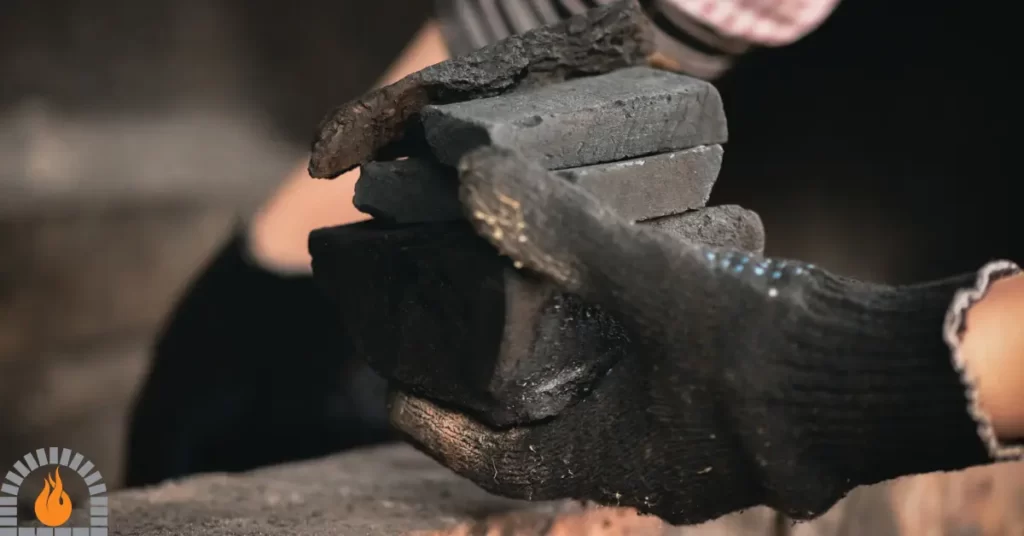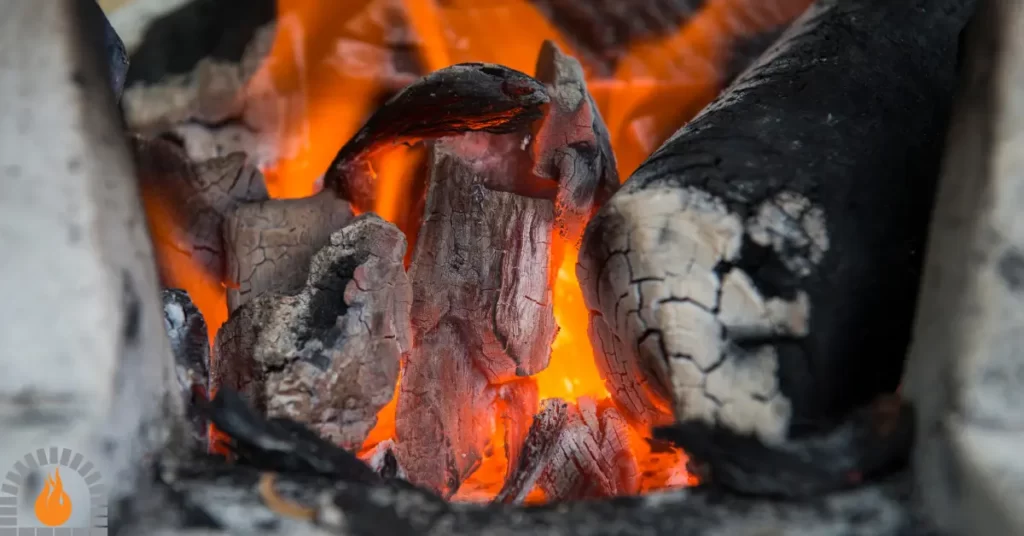Traditionally, wood has been the primary fuel used in fireplaces, but many homeowners wonder if they can use charcoal in fireplace as an alternative. Charcoal is often associated with outdoor grilling, but is it safe and efficient to burn charcoal in a fireplace?
It is not recommended to use charcoal in a fireplace. A study conducted in California aimed to determine the annual incidence rate and factors associated with unintentional deaths caused by carbon monoxide (CO) poisoning from charcoal grills/hibachis. According to the report, 444 confirmed cases of unintentional CO poisoning, with 59 deaths attributed to the improper use of charcoal grills/hibachis.
Why Shouldn’t You Use Charcoal in Fireplace?
Using charcoal in a fireplace can be dangerous and is not recommended for several reasons, Charcoal emits carbon monoxide, a colorless and odorless gas known for its high toxicity. When burnt in a confined space like a fireplace, charcoal can release high levels of carbon monoxide, posing a serious health risk to anyone nearby.
Charcoal can ignite quickly and burn at high temperatures. If not handled properly, it can result in uncontrolled fires, posing a risk of damaging your fireplace, chimney, or entire home.
Charcoal ashes can be more challenging to clean from the fireplace and chimney than wood ashes. They can contain chemical residues that may erode the chimney lining or leave deposits that restrict airflow, potentially leading to a chimney fire or other hazards.
Coal burns hotter and longer than traditional firewood, which can exceed the safe operating temperatures of some fireplaces, especially those not designed to handle such intense heat. This may lead to structural damage to the fireplace and the surrounding area.
It emits a distinctive smell when burned, which can be unpleasant for some people. The smoke from charcoal may not be well-ventilated by the fireplace, leading to smoky rooms and potential respiratory issues.
Using coal may indirectly contribute to environmental degradation.
Charcoal produces more creosote than wood, which can accumulate in the chimney lining over time. Being highly flammable, Creosote can lead to chimney fires if not regularly cleaned.

Understanding Charcoal and Its Variants
Charcoal is a black, porous, lightweight carbonaceous material derived from heating wood or other organic materials without oxygen. This process drives off volatile compounds and water, leaving behind almost pure carbon.
There are two primary types of charcoal available: lump charcoal and briquettes.
Lump Charcoal
Lump charcoal is produced by burning wood in a low-oxygen environment until it turns into charred pieces. It contains no additives or binders, making it a pure and natural choice for grilling and, potentially, fireplace use.
Its irregular shape allows for better airflow, producing higher heat levels and imparting a smoky flavor to food when grilling.
Briquettes
Charcoal briquettes, on the other hand, are made by combining powdered charcoal with binders and additives. While they may be more convenient and cheaper, they may not be the best option for fireplace use.
The binders and additives can release harmful fumes when burned indoors, potentially posing health risks.
Precautions for Safe Usage
To safely burn charcoal in your fireplace, follow these precautions:
-
Ensure the fireplace and chimney are clean and in good condition.
-
Always use lump charcoal instead of briquettes for minimal additives.
-
Install a carbon monoxide detector in the room where the fireplace is located.
-
Open a window to allow fresh air circulation while burning charcoal.
-
Ensure Proper Venting Requirements.
-
Never leave the fire unattended and extinguish it fully before going to bed or leaving the house.
Local Regulations and Restrictions for Burning Charcoal in Fireplaces
Before using charcoal in your fireplace, check your local regulations and restrictions. Some areas may have ordinances prohibiting specific fuels or appliances, including charcoal-burning fireplaces.
Compliance with local laws is essential to ensure your safety and avoid potential fines.

Alternative Fireplace Fuels
If you’re unsure about charcoal, several alternative fuels are safe and efficient for indoor fireplace use. Hardwoods, like maple and oak, are excellent choices as they produce long-lasting and consistent heat.
Synthetic firelogs made from compressed sawdust and wax can be convenient for clean and consistent burning.
Can Charcoal Damage Your Fireplace?
While lump charcoal is generally safer for your fireplace, it can still cause damage if not used correctly. The high heat produced by charcoal can lead to cracks in the masonry, especially if the fireplace is not designed to withstand such temperatures. Regular maintenance and inspections can aid in early identification of potential issues.
FAQs
Can you use charcoal on an open fire?
Yes, you can use charcoal in an open fire. Charcoal is a great fuel source that burns hotter and more evenly than wood. It is often used in outdoor grills and campfires to provide controlled and consistent heat for cooking or warming. However always follow safety guidelines
Is charcoal or wood better for a fireplace?
Charcoal is generally not recommended for indoor fireplaces due to the potential for increased carbon monoxide emissions and the risk of producing more ash. Wood is a better choice for indoor fireplaces since it creates a cozy atmosphere and provides good heat.
However, always follow safety guidelines and local regulations when using any fuel in your fireplace.
What is the difference between coal and charcoal?
The main difference between coal and charcoal lies in their formation and properties. Coal is a fossil fuel formed from remains over millions of years under high pressure. It contains higher carbon content and releases more pollutants when burned.
On the other hand, charcoal is produced by heating wood in a low-oxygen environment, leaving behind mostly carbon.
Can you burn charcoal in a wood stove?
In general, burning charcoal in a wood stove is not recommended. Wood stoves are meticulously crafted to burn wood efficiently and ensure safety. However, employing charcoal as a fuel source can give rise to various problematic outcomes.
Charcoal burns at higher temperatures and produces more heat, which could damage the wood stove or its components. Burning charcoal indoors may increase carbon monoxide levels and release harmful fumes.
Can you burn charcoal in a fire pit?
Yes, you can burn charcoal in a fire pit. Fire pits provide a suitable outdoor setting for using charcoal as a fuel source. Charcoal can be used for cooking, roasting marshmallows, or enjoying a warm and cozy fire in your backyard.
However, always exercise caution when using any fire pit and follow safety guidelines to prevent accidents and ensure responsible disposal of ashes.
Final Thoughts: Can You Burn Charcoal In fireplace?
In conclusion, it is possible to burn charcoal in a fireplace, but it comes with significant risks and safety concerns. If you choose charcoal, use lump charcoal instead of briquettes to reduce additives and fumes. Always prioritize safety by ensuring proper ventilation, using a carbon monoxide detector, and following precautions.
However, it’s essential to understand that using charcoal in a fireplace may not be the best long-term solution due to potential damage to your fireplace and the inherent risks.
Exploring alternative fireplace fuels can be a safer and more sustainable choice to keep your home warm and cozy. Stay safe and informed when using your fireplace; always prioritize safety above all else.
Affiliate Disclosure: Fireplaceadviser.com is a participant in the Amazon Services LLC Associates Program. We may earn a commission when you click on certain links on this site and purchase.

Hello!! I am Jamal Khan. I often fix my home electric heaters and gas stove problems and research the common issues in the heating units to improve my knowledge and expertise. The aim of establishing fireplaceadviser.com is to share my expertise and knowledge with my audience.












